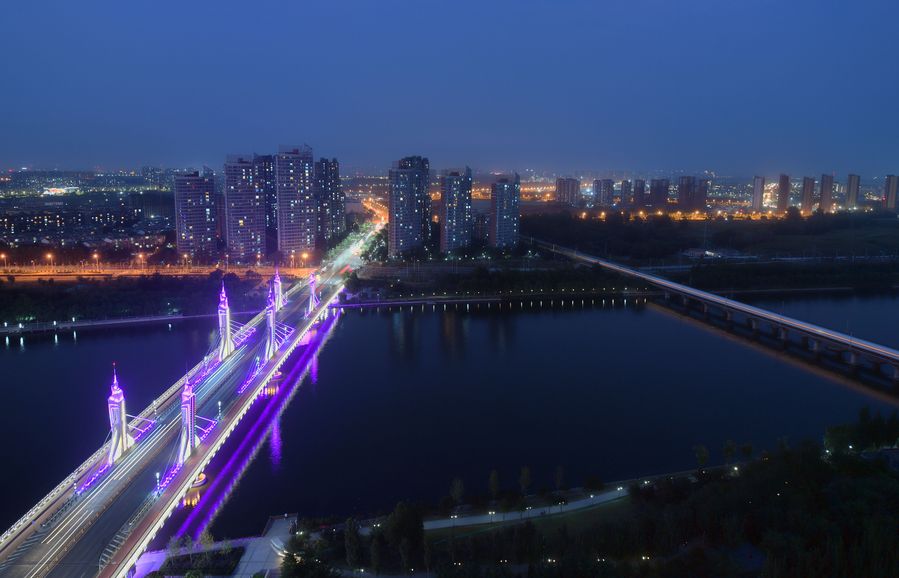Beijing's sub-center rises from blueprint to scale
 0 Comment(s)
0 Comment(s) Print
Print E-mail Xinhua, January 13, 2020
E-mail Xinhua, January 13, 2020

West of the 6th Ring Road in Beijing, construction of the widely anticipated Universal Beijing Resort is in full swing.
The initial phase of the project, which includes the Universal Studios theme park, the Universal CityWalk commercial complex and two resort hotels, is going to receive visitors in 2021.
"The project, after completion, will play a leading role and provide an impetus for the socio-economic development of the surrounding region," said Xu Liping, the resort's vice president of government affairs.
Beijing will step up efforts to promote the high-quality growth of its sub-center, said mayor Chen Jining in his government work report delivered Sunday at the opening meeting of the annual session of the municipal people's congress.
Priorities will be given to the sub-center in selecting venues for pilot programs, key projects, high-performance companies and technological applications, Chen noted.
As implementation of the control plan for Beijing's sub-center construction in the eastern suburb of Tongzhou District speeds up, a more livable, business-friendly city with good working conditions is taking shape, sparkling with vigor and vitality.
A new flapping wing
Another mega project has started construction to the west of some key municipal organs of Beijing, which moved their offices from the downtown area to the city's sub-center.
The 1.3 million-square-meter underground transportation hub, the largest of its kind in Asia, is scheduled to be ready for traffic by the end of 2024, linking cross-regional and intercity railways, and several metro lines.
Travel time to Xiong'an New Area in the neighboring Hebei Province will be reduced to one hour and it takes only 15 minutes to reach Beijing Capital International Airport, and 35 minutes to get to the new Beijing Daxing International Airport.
With a founding history of more than 2,200 years, Tongzhou is the north end of the Beijing-Hangzhou Grand Canal and served as the gate of grain shipping to China's imperial capital in ancient times.
Zhangjiawan, historically a key port along the canal where the 16th-century Italian priest Matteo Ricci landed to enter the capital city, used to be a major industrial town in Tongzhou with more than 1,000 industrial enterprises.
As the district ramps up effort to shut down businesses and factories that fail to meet the sub-center's urban utility and environmental standards, Zhangjiawan is becoming a characteristic design town focusing on creative design and urban technology.
Located in the emerging design town, Topnew, a traditional knitwear manufacturer, has had its unused factory buildings replanned and repurposed as the company moved its main business segment out.
"The old industrial area, under unified planning with the integration of design and technological resources, will be built into a world-class, energetic fashion design block," said Cao Zonghe, Topnew's general manager.
The design town in Zhangjiawan became the permanent site of the Beijing Design Week last September and saw 33 enterprises centering on fine urban management, social services and emerging industries settled in December 2019.
Tongzhou was positioned as Beijing's "satellite town" in 1993 and then a "new town area" before the 155-square-km sub-center was planned.
Today, as one of Beijing's "two new wings" along with Xiong'an New Area, the sub-center has set a model of quality-driven development by gathering a variety of superior resources.
The sub-center has witnessed the settlement of headquarters of centrally-administered state-owned enterprises, branches of state-owned commercial banks, high-tech companies, a national cybersecurity industrial park and a human resource service park.
Tongzhou is also at the forefront in building a pilot area as Beijing pushes for further opening of its service sector, with the actual use of foreign capital and total foreign trade volume growing by 8.4 percent and 15 percent year on year respectively in 2019.
"We had a solid start in 2019, and will bring in more suitable industries to make the sub-center a vibrant city," said Hu Jiulong, deputy director of the sub-center's management committee.






Go to Forum >>0 Comment(s)